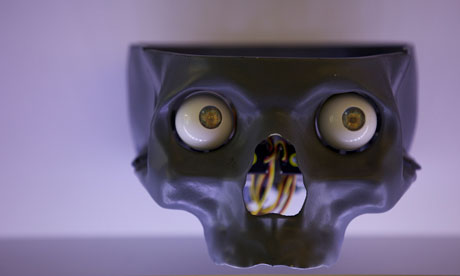HUMAN+ explores the technologically enhanced future of our species
Michael John Gorman, director of the Science Gallery, Trinity College Dublin, introduces the HUMAN+ exhibition – 'a combination of a sweet shop and a pharmacy, an Alice-in-Wonderland world of pills, promises and prosthetics'

Area V5 by Louis Philippe Demers evokes the physical unease humans experience with robotic agents. Photograph: Patrick Bolger/Science Gallery
What do we mean when we speak about human enhancement? New York University professor Wafaa Bilal recently had a video camera implanted on a titanium base in the back of his skull. Leaving wires dangling awkwardly along his neck, the camera sent images to a remote server every 60 seconds. Students' concerns over their privacy, faced with a teacher who for once really did have eyes in the back of his head, forced Bilal to wear a lens cap while teaching, somewhat defeating the point.
A few months later an infection forced Bilal to remove the camera, and simply wear it around his neck, but he remains keen to have it back in his skull as soon as possible. Why? What is the difference, you might wonder, between a camera strapped to someone's neck and the same camera attached to the skull with a titanium plate? To Bilal, it is all about a demonstration of 'commitment', making the painful surgery and risk of infection worthwhile. Bilal's messy piece of DIY illustrates some of the challenges around popular perceptions of human enhancement.
Australian artist Stelarc has grown a third ear in a lab and inserted it into his left forearm. Nina Sellars' arresting photographs of the process are on view in HUMAN+. Stelarc hopes to insert a bluetooth microphone into the ear so people all over the world can listen in to his conversations over the internet, though the completion of this aspect of the project has so far been delayed by infection.
For a small fee, body artist Steve Haworth will provide you with small magnets implanted in your fingertips so you can "feel" the presence of magnetic fields. Cybernetics Prof Kevin Warwick hit headlines when he had an RFID chip implanted in his arm to allow him to open and close doors, prior to more sophisticated experiments on direct neural/electronic interfaces. Warwick caused even more controversy when he reportedly suggested that an 11-year-old girl should be "chipped" with a tracking device in the wake of the Soham murders, in a similar manner to pet dogs and cats.
These stories have perennial fascination for the media, perhaps less for the "superpowers" of their protagonists, which could arguably be accomplished through less radical interventions, and more for their disturbing transgressions of the boundaries of the human body. We seem to fantasise endlessly about cyborgs – Robocop-style human-machine hybrids – but many of the dimensions of human enhancement are far more subtle and pervasive.
Humans have always been augmenting their senses, physical powers and cognitive abilities through ingenious tools and technologies. The Hubble telescope, functional magnetic resonance imaging and atomic force microscopes can be viewed as extensions of the senses, just as our newfound ability to gather "swarm intelligence" about developments in Libya or Japan instantaneously through social media is an extension of the campfire conversations of Neolithic man. We are continually developing new ways to see the invisible, to share knowledge and conduct our social lives remotely. In attempting to defeat ageing processes, cosmetic surgery promises to extend youthful appearance as Viagra promises to extend our sexual activity into old age.



No comments:
Post a Comment